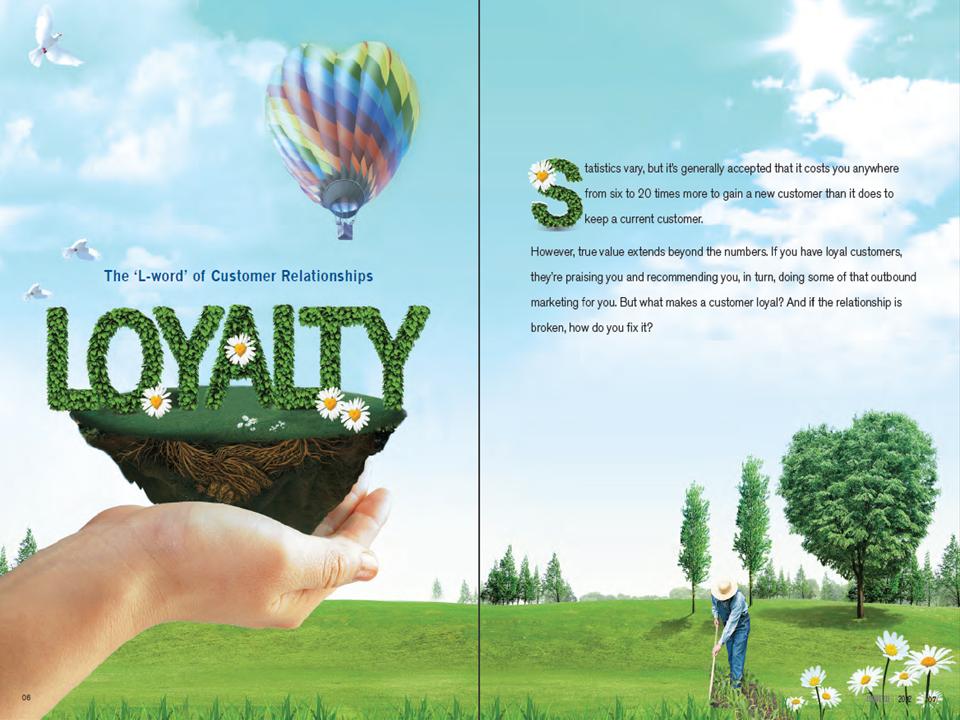Employee loyalty builds customer loyalty, which builds brand loyalty. It’s as simple - and as difficult - as that.
Marketing Insider - Loyalty: The ‘L-word’ of Customer Relationships


Loyalty: The ‘L-word’ of Customer Relationships
Statistics vary, but it’s generally accepted that it costs you anywhere from six to 20 times more to gain a new customer than it does to keep a current customer.
However, true value extends beyond the numbers. If you have loyal customers, they’re praising you and recommending you, in turn, doing some of that outbound marketing for you. But what makes a customer loyal? And if the relationship is broken, how do you fix it?
Dianne Durkin, founder and president of Loyalty Factor, a consulting and training company that enhances employee, customer and brand loyalty, says customer loyalty is actually a partnership. To glean the most value from customers, you need to provide value to them, too.
Loyal customers help your business grow
They are your biggest advocates. They recommend you and can introduce you to new clients. And they don’t mind at all. According to Durkin, using these advocates as references helps them to feel needed and valued which translates well into something crucial for relationships: rapport and true connection. “People buy from people, they don’t buy from companies,” Durkin says. “To build rapport, treat other people the way you want to be treated and always build trust.”
It’s important to nurture your customer relationships and avoid breakdowns in communication. Durkin says one of the most common ways to lose loyalty is failing to follow through on what you’ve promised, frequently a delivery date or time. What is the cost?
• A dissatisfied consumer will tell between nine and 15 people about their experience. About 13% of dissatisfied customers tell more than 20 people. (White House Office of Consumer Affairs, 2011)
• 86% of consumers will pay up to 25% more for better customer experience. (Harris Interactive, Customer Experience Impact Report, 2011)
• It takes 12 positive service experiences to make up for one negative experience. (“Understanding Customers” by Ruby Newell-Legner)
Remember those VIPs known as company advocates? Losing a customer means you’re also losing all of the additional business an advocate could have sent your way. So, how do you repair the damage that’s done?
Durkin says one of the most important things to do after admitting a mistake is to ask a customer how you can make it up to them. This means listening. “Questions are your secret weapons,” she says. “Ask, ‘What would you recommend I do to help in this situation?’ Or, ‘If you were in my shoes, what would you do?’”
Unhappy customers have many more communications channels and ways to reach a larger audience than ever before. Here are some of Durkin’s “fix-it” strategies:
Negative online review
Some may not be worth paying attention to, but those that could have far-reaching effects should be addressed. If possible, send a personal email to the disgruntled party and post a public response that explains your steps to make it right.
Negative comments on social networking pages
The right approach is situational, but Durkin recommends always keeping your social network current with your most positive commentary. Delete comments that are inappropriate or offensive. Engage your advocates, and ask if they’ll reach out to others on your behalf. When you have advocates willing to help you, Durkin says it’s best to draft what you want to say and then have your advocates deliver your messages.
Email with an error
Should you send a correction? According to Durkin, it depends. A misspelling of a customer’s name may not be worth calling attention to, but if you have an erroneous amount in an offer, that’s a different story. Durkin recommends sending a correction email that says: “In the excitement of this offering, we miscommunicated. We want to take the opportunity to clarify and to thank you for your business.”
Dormant accounts
How do you determine if you’ve let these former customers down, and how can you win them back?
Pull out a list of those with whom you haven’t done business in the past year. Mail a letter, package or postcard to them with a “welcome back” offer, if appropriate.
“Or hire an outside firm to call dormant accounts,” Durkin says. “They will tell the surveyor things they will never, ever tell you. To get the most useful information, the surveyor should ask specific questions such as, ‘Tell me why you no longer do business with company X.’ and ‘If there’s something company X needs to stop doing, what is it?’”
Durkin says that even after getting responses, more questions should be asked. For example: if a customer says you can win them back with a discount, ask why it’s important to them. There may be a buried solution to uncover. And overall, these calls should always sell the value of what you offer that can’t be found anywhere else.
http://www.allegra-east.com/thinking-behind-marketing-results/insider
©2012 Allegra Network www.allegranetwork.com
Posted with permission



